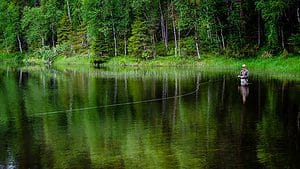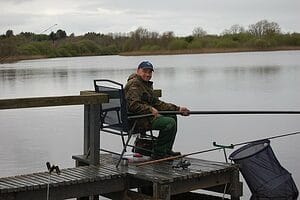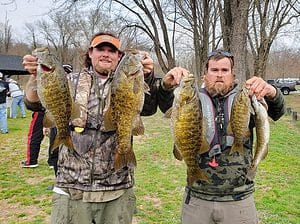Disclosure: Some posts contain affiliate links, which earn us a commission if you make a purchase through them. Positive Fishing © participates in various affiliate networks including the Amazon Services LLC Associates Program.
Fishing, in one form or another, is one of the most popular sports in both the United Kingdom and the United States.
But are the Yanks and the Brits fishing in the same way? What are there some differences in styles and tactics? That is what we are here to find out.
Join me as we compare the sport of fishing between the UK and the US, including the species that can be caught, the techniques, and the commercial aspect.
Geography & Species
If we want to look at the differences between fishing in the UK and the USA, we first have to start with the geography of the two countries and the species that inhabit them.
America is a big country; you can fit the UK into the USA forty times over. Being so much bigger, America naturally offers many more fishing opportunities than the UK, with a much broader range of species and environments to target.
Since the US spans a massive longitude from Florida and the Gulf of Mexico up to Alaska, the range of species differs greatly from the UK, particularly in the sea.
In the US, you can target awesome species like bonefish, permit, tarpon, sailfish, tuna, and marlin, whereas the most exciting species in the seas off the UK are sea bass, cod, and the occasional blue shark.
In comparing freshwater species, there are also some big differences. However, the cold freshwater species like trout, pike, carp, salmon, and grayling are something both countries share. But there are many more trout species, salmon, and predatory pike in the US.
America also has a lot of freshwater species, including the popular duo of smallmouth and largemouth bass. The waters of the UK have neither of these most commonly found fish.
UK Fly Fishing vs USA Fly Fishing

The one form of fishing that has the most similarities is fly fishing. Fly fishing was born in the UK and is immensely popular but not as widespread as in the USA.
Fly fishing in Britain usually involves targeting brown and rainbow trout in reservoirs and rivers, and there are some great places to fish, like the chalk streams of Hampshire and the rivers of Wales, northern England, and Scotland.
Uk fly fishing also involves swinging flies for Atlantic salmon and sea-run brown trout, which is probably considered the pinnacle of fly fishing in the UK.
When freshwater fly fishing in the USA, you have a plethora of trout rivers and trout species to target, from golden trout in California to wild rainbows, browns, cutthroats, and more across the rocky mountains of Montana and Wyoming, all the way to the rivers on the east coast of Pennsylvania, Washington, and Maine.
You can also find Atlantic salmon fishing on the east coast of the USA, and something the UK doesn’t have is the sea-run rainbow trout of Washington and Oregon, known as the steelhead.
If you were to go fly fishing in Alaska, the range of salmon species on offer is out of this world, as are their numbers; it simply makes the UK look like a fishless country in comparison!
Something that has blossomed recently is saltwater fly fishing in the UK, and fly anglers target both mullet and sea bass on the fly. But, these kinds of anglers are not easy to come by, and when you compare it to saltwater fly fishing in the USA, the UK is pretty pitiful. You can target many saltwater species in the USA with a fly rod, including striped bass, blue fish, red fish, speckled trout, permit, bonefish, tarpon, snook, jacks, and more.
These are some of the coolest saltwater species you can catch on a fly rod, and it has created a saltwater fly fishing culture and industry that is not apparent in Britain. The beaches in England, Wales, and Scotland have no saltwater flats, so to speak, and the areas that might be similar to them are only frequented by rather boring and much smaller species.
If you head to Florida, for example, which is probably the saltwater fly fishing capital of the world, you will find thousands of fly fishing guides ready to put you on these amazing species, and there are thousands of willing customers, too.
UK Sea Fishing vs USA Sea Fishing
As we already discussed, the oceans surrounding the two countries have a very different range of species.
Sea fishing in the UK usually involves jigging on wrecks for species like cod, flounder, pollock, and mackerel. But you will also find anglers targeting sharks, surf fishing from the beach for flounder and bass, and doing some trolling around solid structures.
Comparing the UK sea fishing to the USA sea fishing couldn’t be more different. The east coast of the USA is home to blue marlin, white marlin, sailfish, mahi-mahi, bluefin tuna, Spanish mackerel, wahoo, and a load of different bottom fish species, too. The list is never-ending!
When sea fishing, American anglers can deploy a huge range of tactics, from pulling teasers for blue and white marlin to fishing with large live baits for sailfish, chunking and trolling for tuna, and bottom fishing for table fish species.
As you can see, sea fishing in both countries is extremely different, mainly down to the species available. The one thing they have in common is that they both have a ton of anglers who love going out to sea and catching fish.
UK Spin Fishing vs USA Spin Fishing

If someone asked me what the main freshwater fish people in the UK target, my answer would be carp. If you asked me the same question about the USA, I would say bass.
Anglers in the USA love catching smallmouth and largemouth bass; they are the species with which 90% of USA anglers start their fishing careers. You are never far from a bass pond in the USA, so it makes sense that beginners start there since fishing is so accessible.
In the UK, anglers usually start fishing by trying to tempt carp or roach with a few maggots sitting under a float. This is also because carp fishing and general coarse fishing are readily available and affordable.
Now, consider the differences in these fishing approaches. On the one hand, in the UK, you have anglers sitting in chairs or in bivvies waiting for a bite alarm to trigger in the hope of catching a carp. Or they are sitting in their chairs or seat boxes waiting for the float to go under and catch roach or other silverfish.
In the USA, anglers are casting big bass lures like spinner baits across a lake and waiting for a bass to smash it out of nowhere.
It goes without saying, in my opinion anyway, that casting a lure and waiting for a predator to come out of cover and engulf it on the surface is a very exciting form of fishing, a lot more so than waiting for a carp to come along and eat some maggots under a float.
I think this is a major key difference in the angler’s enthusiasm for fishing, and they want to explore more of it.
In my experience, those anglers in America tend to like multiple forms of fishing, from fly to offshore and freshwater, whereas the majority of British anglers I know stick to one form: coarse, sea, or fly fishing.
The closest similarity in both countries is that spin fishing targets predatory species like pike. While in the UK, you have pike, perch, and zander, in the USA, you have Northern pike, muskie, perch, and other similar species, but the tactics used to catch them are identical.
Anglers in both countries will use live bait, dead bait, lures, and spinners to tempt pike out of big rivers and lakes.
USA vs UK Catch & Release Fishing
In the UK, catch and release fishing is ingrained in the culture and much more than in the USA.
No coarse anglers catching pike or carp intend to take the fish home for dinner, and when it comes to species like salmon and trout, 99% of them will be released in the UK.
This makes the fish in the UK quite hard to catch since they get wise to the different bait anglers use and are better at telling if there is a hook in their food before they eat it.
When it comes to catch and release fishing in the USA, chances are if a good trout are caught in a lake by an angler, it is coming home for dinner, which would apply to any panfish species such as crappies and bluegill too.
That being said, America’s catch and release culture has come on leaps and bounds, and it is very common these days, particularly in the fly fishing industry.
Specimen Hunter Fishing
In the U.K., one of the largest growing areas in fishing is targeting specimen carp, tench, and barbel. The tactics for this fishing is to discard targeting all other fish species and only concentrate only on these particular species. Syndicate fishing is becoming a rapidly growing pastime in the UK.
In the United States, there is very little of this somewhat unique style; however, carp fishing in the US has grown in popularity over the past few years, but carp remains a pest or even a trash fish to most anglers.
Match Fishing vs Bass Tournaments

different – including the species and rules.
The match fishing scene is a huge draw for many anglers in the UK. Every Saturday, Sunday, and even mid-week matches are extremely popular with many anglers. The most prestigious event in the UK is the Fishomania event held yearly, which attracts a first prize of £50,000.
These matches typically last for five hours, and all species are targeted and weighed at the end for the largest combined weight.
The only real comparison is the bass tournaments held in many rivers and lakes across the United States. These bass tournaments are single-fish tournaments and are generally focused on the largest bass caught as well as the total weight.
Lastly, there are big-money tournaments, such as the White Marlin Open in Ocean City, Maryland, where the prize can reach over $1m. These saltwater offshore tournaments are based on fishing for large Marlin, tuna, and wahoo.
In reality, match fishing and tournament fishing are totally different and unique to each country.
Conclusion
The United States has a far wider range of fishing species and styles, especially regarding sea angling. The United Kingdom has a wider range of coarse fishing styles and methods, especially in specimen and competitive angling.
Fly fishing is popular in both countries. The United States has more species available when fly fishing in the sea and rivers. However, the quaint chalk streams and tranquil locations in the United Kingdom are as beautiful as anywhere in the world.
Both countries have a similar range of fish and fishing methods for predatory coarse fish.
Winding Up
Thanks very much for reading my article. I hope you enjoyed it and have learned how different fishing is in the two countries.
The nice thing is both the Brits and Yanks love fishing, and the passion is shared whenever anglers from the two countries meet.
Please share the article with your fishing buddies and look at some of our others. We cover over 40 fishing destinations worldwide, including the Americas, Europe, and Asia.
- 5 Best Fishing Bags For Getting Your Gear Organized - January 13, 2025
- 4 Essential Surf Fishing Rigs - January 11, 2025
- How To Know The Sex Of A Fish You Have Caught? - December 9, 2024
